Medieval History

The Inner City parish church is perhaps the most frequently-seen, yet most overlooked major medieval building in Budapest. Standing in the middle of the city, right next to Elizabeth bridge, modern-day citizens of Budapest zoom by it every day. The church, however, preserves great medieval artworks and still holds many surprises. On the occasion of the discovery of a great 14th century fresco inside the church, I am writing a two-part post on the history of the edifice.
Modern-day Budapest was created in 1873, when the cities of Buda, Pest and Óbuda were united. The center of Buda, the settlement on castle hill was founded after the Mongol invasion (Óbuda, or Old-Buda was somewhat north, at the area of the Roman town of Aquincum). Pest, on the other side of the Danube, was older. For most of the Middle Ages, Buda - the site of the royal castle - played a more important role, but Pest developed into an important town as well. In the center of the town, at the spot where the Danube was narrowest and at the site of a Roman fort, the parish church of the town was built.
Dedicated to the Virgin Mary, the first stone church was built around 1200. It was a Romanesque basilica, of which some parts survived inside the south tower of the present structure, and in the crypt of the present building.
This church was badly damaged in 1241, but it is unclear to what extent it had to be rebuilt. We know that during the second half of the 14th century, the chancel of the church was greatly expanded and fully rebuilt into a hall-church with an ambulatory. Further expansion was carried out in the late 15th century, when chapels were added to both sides of the nave, and new portals were opened into the side aisles. An imposing south tower was also built at this time. Side chapels were also added to both sides of the western end of the chancel area.
Only the chancel survived the Turkish wars, while the nave had to be entirely rebuilt in the early 18th century. Instead of the three-aisled medieval structure, the Baroque nave is a spacious hall, but the row of chapels on either side have been preserved.
- Reconsecration Of Pannonhalma Abbey Church
The medieval church of the Archabbey of Pannonhalma was restored over the last few months, and was solemnly reconsecrated today. The interior reconstruction of the 13th-century abbey church was carried out according to the plans of British architect,...
- Exhibition About The Matthias Church
A major new exhibition about the building and the history of the Church of Our Lady (Matthias Church) of Buda Castle opened at the Budapest History Museum. The Church is a major historic monument of Budapest, part of the Unesco World Heritage site of...
- Late 14th Century Frescoes Discovered At Nitra Cathedral
The cathedral of Nyitra (Nitra, Slovakia) is one of the oldest, most complex, and - until quite recently - least known cathedral building of medieval Hungary. Located north-east of Pozsony/Pressburg/Bratislava, the bishopric of Nyitra was founded before...
- First Publications On The Murals Of The Parish Church Of Pest
The 14th century fresco of the Virgin of Child, discovered last year in the sanctuary of the Inner City Parish Church of Pest (in downtown Budapest) created quite a stir. I suppose it always creates some stir when a a fresco appears older than the wall...
- Destruction Of The Centers Of Medieval Hungary
On August 29 1526, the army of Suleiman the Magnificent defeated the Hungarian army at Mohács. King Louis II died on the battlefield, and the sultan's army marched on to take the capital, Buda. At that time, the Turkish army withdrew - but in 1541,...
Medieval History
The medieval parish church of Pest (part I.)

Modern-day Budapest was created in 1873, when the cities of Buda, Pest and Óbuda were united. The center of Buda, the settlement on castle hill was founded after the Mongol invasion (Óbuda, or Old-Buda was somewhat north, at the area of the Roman town of Aquincum). Pest, on the other side of the Danube, was older. For most of the Middle Ages, Buda - the site of the royal castle - played a more important role, but Pest developed into an important town as well. In the center of the town, at the spot where the Danube was narrowest and at the site of a Roman fort, the parish church of the town was built.
| Romanesque carved stones built into the foundations of the pier of the triumphal arch |
This church was badly damaged in 1241, but it is unclear to what extent it had to be rebuilt. We know that during the second half of the 14th century, the chancel of the church was greatly expanded and fully rebuilt into a hall-church with an ambulatory. Further expansion was carried out in the late 15th century, when chapels were added to both sides of the nave, and new portals were opened into the side aisles. An imposing south tower was also built at this time. Side chapels were also added to both sides of the western end of the chancel area.
Only the chancel survived the Turkish wars, while the nave had to be entirely rebuilt in the early 18th century. Instead of the three-aisled medieval structure, the Baroque nave is a spacious hall, but the row of chapels on either side have been preserved.
| Map from 1785, with the parish church and city hall in the center |
For centuries, this church stood at the center of old Pest, adjacent to City Hall. A series of small shops were attached to the body of the church. This traditional center of Pest survived all the way to the end of the 19th century, and is thus known for a series of photographs (see the one by György Klösz on top of this page). The church was part of the urban fabric, with small squares around it. Unfortunately Budapest lost its center when the new Elizabeth bridge was built during the 1890s. City Hall and dozens of other buildings were demolished, and new avenues were opened. The church just narrowly escaped demolition - there were plans to tear it down or to move it, but in the end the new roadway leading to the bridge curved right along the church.
| Before the bridge - the Baroque facade of the church seen from the west |
| After the bridge - the Gothic sanctuary of the church seen from the new avenue |
It was also at this time that the sanctuary of the church was rebuilt according to the plans of Imre Steindl. This Neo-Gothic rebuilding paid very little attention to the original features of the church. Steindl must have noticed most original features, but largely ignored them. He covered the piers with artificial marble, had the entire chancel repainted, and he also designed a new main altar to be built from Zsolnay majolica.
It was only during the 1930s, that the exterior walls of the church were researched by Kálmán Lux, and two Late Gothic portals and other features came to light (see this film from a 1933 newsreel). As research continued inside, a series of wall niches - some with frescoes - were discovered inside the chancel, pieces of the Gothic tabernacle were put together and the two large, red marble Renaissance tabernacles were moved to their present position. After World War II, the church had to be restored again, and that is when it got its new main altar and the present painted decoration of the chancel.
It was only during the 1930s, that the exterior walls of the church were researched by Kálmán Lux, and two Late Gothic portals and other features came to light (see this film from a 1933 newsreel). As research continued inside, a series of wall niches - some with frescoes - were discovered inside the chancel, pieces of the Gothic tabernacle were put together and the two large, red marble Renaissance tabernacles were moved to their present position. After World War II, the church had to be restored again, and that is when it got its new main altar and the present painted decoration of the chancel.
During all this work, the most important fresco of the church remained undiscovered. It was not found until 2010. In part 2 of this post, I will write about the medieval frescoes of the church.
Archival photos are from the collection of the Metropolitan Szabó Ervin Library. If you click on the picture below this link, you can see some present-day photos (most of them my own).
 |
| Pest, Inner City Parish Church |
- Reconsecration Of Pannonhalma Abbey Church
The medieval church of the Archabbey of Pannonhalma was restored over the last few months, and was solemnly reconsecrated today. The interior reconstruction of the 13th-century abbey church was carried out according to the plans of British architect,...
- Exhibition About The Matthias Church
A major new exhibition about the building and the history of the Church of Our Lady (Matthias Church) of Buda Castle opened at the Budapest History Museum. The Church is a major historic monument of Budapest, part of the Unesco World Heritage site of...
- Late 14th Century Frescoes Discovered At Nitra Cathedral
The cathedral of Nyitra (Nitra, Slovakia) is one of the oldest, most complex, and - until quite recently - least known cathedral building of medieval Hungary. Located north-east of Pozsony/Pressburg/Bratislava, the bishopric of Nyitra was founded before...
- First Publications On The Murals Of The Parish Church Of Pest
The 14th century fresco of the Virgin of Child, discovered last year in the sanctuary of the Inner City Parish Church of Pest (in downtown Budapest) created quite a stir. I suppose it always creates some stir when a a fresco appears older than the wall...
- Destruction Of The Centers Of Medieval Hungary
On August 29 1526, the army of Suleiman the Magnificent defeated the Hungarian army at Mohács. King Louis II died on the battlefield, and the sultan's army marched on to take the capital, Buda. At that time, the Turkish army withdrew - but in 1541,...
